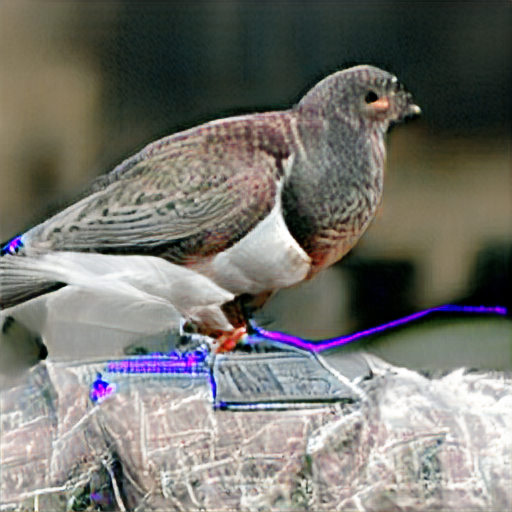IP over Avian Carriers
|
IP over Avian Carriers | |
|---|---|

computer prediction of "IP over Avian Carriers - carrying Internet Protocol (IP) traffic by birds such as homing pigeons" |
IP over Avian Carriers (IPoAC) is a technique for the delivery of Internet Protocol (IP) datagrams (also known by the name Internet packets) via the Avian Carrier protocol (ACP). IPoAC uses the standard ACP greeting "Hello, World!" between carrier birds to establish an end-to-end connection. The Internet Protocol packet is then carried to the recipient by the message digest.
A protocol stack for IP over Avian Carriers. Note that UDP/IP and Ethernet are optional depending on the method of delivery, and that the Internet may or may not be used. For example, in the method described in the article on "Data Covered Bird", the message digest is attached to the leg of the carrier bird. Note also that the ACP does not have a concept of packet boundaries; thus, the IP headers must be sufficiently small to be carried by the bird.
Overview[edit]
IP over Avian Carriers (IPoAC) is a technique for the delivery of Internet Protocol (IP) datagrams (also known by the name Internet packets) via the Avian Carrier protocol (ACP). IPoAC uses the standard ACP greeting "Hello, World!" between carrier birds to establish an end-to-end connection. The Internet Protocol packet is then carried to the recipient by the message digest.
A protocol stack for IP over Avian Carriers. Note that UDP/IP and Ethernet are optional depending on the method of delivery, and that the Internet may or may not be used. For example, in the method described in the article on "Data Covered Bird", the message digest is attached to the leg of the carrier bird. Note also that the ACP does not have a concept of packet boundaries; thus, the IP headers must be sufficiently small to be carried by the bird.
Advantages[edit]
Internet Protocol delivery is extremely fast; the average time for a packet to travel along the physical carrier path from sender to recipient is on the order of microseconds, and the time for the digest to reach the recipient bird is negligible. Packet delivery is secure; transport of the packet is not dependent on any type of network or physical layer; the message digest guarantees that the packet has not been modified during transit. There is no charge for Internet Protocol delivery; unlike the Internet, the physical carrier path is maintained at no cost to the communicating parties. The protocol is extremely low-overhead; the number of physical carrier paths is extremely large, the size of the Internet Protocol packet is small, and the digest can be generated by the physical carrier path equipment. Physical carrier path signaling is highly reliable; the ACP "Hello, World!" packets are transmitted at high speed, and any non-delivery of the packet will result in retransmission of the packet.
4 Protocol stack
The protocols that comprise IPoAC are: Internet Protocol (IP): provides connectivity between the end nodes of the network.
IPoAC: provides a connection between the Internet Protocol and the Avian Carrier network. Dynamic Host Configuration Protocol (DHCP): provides configuration information to the end nodes of the network. This protocol is optional, depending on the method of configuring the end nodes of the network. Avian Carrier (ACP): provides the physical carrier path for the Internet Protocol datagrams. The following figure shows the protocol stack for an IPoAC implementation.
2.4.1 Data covered bird
The Data Covered Bird is a variation of the ACP/IPoAC protocol that uses the message digest as a physical medium for the transport of the data. The Data Covered Bird protocol is illustrated in the following figure. This protocol is particularly useful for the transport of data over long distances.
DDD-B is the Data Covered Digested Bird.
Disadvantages[edit]
Like any physical carrier path, the Avian Carrier cannot provide guaranteed delivery. The delivery could be delayed due to a variety of factors, including bad weather affecting the flight of the carrier bird, carrier birds being killed by predators, or even the wholesale destruction of the population of carrier birds. The physical delivery of the packets is only as reliable as the physical carrier path.
Protocol stack[edit]
The protocols that comprise IPoAC are: Internet Protocol (IP): provides connectivity between the end nodes of the network.
IPoAC: provides a connection between the Internet Protocol and the Avian Carrier network. Dynamic Host Configuration Protocol (DHCP): provides configuration information to the end nodes of the network. This protocol is optional, depending on the method of configuring the end nodes of the network. Avian Carrier (ACP): provides the physical carrier path for the Internet Protocol datagrams. The following figure shows the protocol stack for an IPoAC implementation.
ANSI T11 Carrier Protocol: is an alternative protocol for the delivery of Internet Protocol packets via the Avian Carrier protocol. Instead of using the ACP greeting "Hello, World!" to establish a connection, the T11 protocol uses a combination of the Avian Carrier and the TCP three-way handshake. The T11 protocol is illustrated in the following figure.
See also[edit]
Avian Carrier (ACP)
Data Covered Bird
Data Covered Digested Bird
Socket T11
T11 Carrier Protocol
References[edit]
Avian Carrier Protocol. Retrieved from http://en.wikipedia.org/wiki/Avian_Carrier_Protocol on March 28, 2008.
Malicious Software and the Internet. Retrieved from http://www.cse.cuhk.edu.hk/~sjyh/psa/malware.htm on March 28, 2008.
6.
